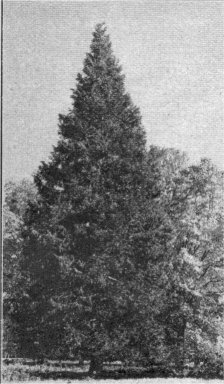
[click to enlarge]
| Online Library: | Title | Author | California | Geology | History | Indians | Muir | Mountaineering | Nature | Management |
Yosemite > Library > Cone-bearing Trees > Incense Cedar >
Next: Western Juniper • Contents • Previous: California Nutmeg
Libocedrus decurrens Torrey.

[click to enlarge] |
The lower branches of younger trees sweep outward and downward almost to the ground while those on the upper portion of the tree ascend. On them hang the sprays of foliage composed of numerous branchlets that are unique among the conifers of Yosemite in being flattened and disposed vertically. These flattish sprays sag from the limbs except near the tops of the trees and at the ends of the branches where they stand upright, similar to the upturned tips of the Western Yellow Pines.
The fragrant foliage consists of scale-like leaves which so completely cover and conceal the slender branchlets that the branchlets might be mistaken for needles if not examined closely. But when inspected, the stems of the branchlets are found to be sheathed within a complete covering of short leaves which tightly overlap one another like shingles on a roof. As twigs grow and develop the leaves are gradually shed revealing the lustrous red bark beneath. When crushed, a pungent odor is emitted from minute glands on each leaf. The aromatic perfume of the leaves as well as that of the wood is responsible for the name Incense Cedar. The scientific name Libocedrus decurrens has reference to this fragrance for the word Libocedrus is derived from two Greek words Libas meaning frankincense and Cedrus meaning cedar.
The rapidly tapering trunk of mature trees swell considerably at the base. They are covered with thick (six to eight inches), cinnamon-red, deeply fissured and vertically ridged hark which contains but little pitch. Because of this protection Incense Cedars are seldom consumed by forest fires. The dwellings (u-mut-ca) of the Yosemite Indians were made of slabs of this bark. It is due to the bark color and texture and to the buttressing of the bases of Incense Cedars that many Yosemite visitors believe erroneously they have seen Big Trees or Giant Sequoias in Yosemite Valley. That there is a decided resemblance must be admitted. While a few Big Trees have been transplanted to the valley within the last sixty years none are mature; and the transplants an all too small to be confused wits mature Incense Cedars.
In September, small, light green, urn-shaped cones hang from the ends of the upper branches. They average about an inch in length and when dry and open are reddish-brown. The three prominent scales resemble the conventional sketch of the fleur-de-lis. Staminate flowers of Incense Cedars bloom in the winter. Then the trees are mantled with small male catkins that produce a golden glow on the upper portions of the trees.
Incense Cedar, the second most abundant conifer in Yosemite Valley, is the only species of its genus, Libocedrus, native to North America where it grows from southern Oregon, throughout the mountains in California, and into Lower California. Its vertical range in the central Sierra Nevada lies between 3000 and 5500 feet. It reaches its maximum development in moist valleys at about 4000 feet elevation. On the floor of Yosemite Valley trees one hundred forty feet high and six feet in diameter at breast height are not uncommon.
Although called a cedar, Incense Cedars are most closely related to the true Cypress and Thuja or Arborvitae with which they are frequently confused due to the flattened branchlets. The genus Cedrus, or true cedar, is not native to North America. The name “Cedars of Lebanon” is familiar to many people because of its scriptural record. These are true cedars and grow in Syria and Asia Minor. The other true cedars in the world, Deodar Cedar and Atlas Cedar, are found in the Himalaya Mountains of southern Asia and Atlas Mountains of northern Africa respectively. Excepting these three species, all others called cedars are improperly named. The aromatic wood of cedar chests is frequently obtained from Incense Cedars, but the wood is used more extensively for shingles, railroad ties and pencils.
Next: Western Juniper • Contents • Previous: California Nutmeg
| Online Library: | Title | Author | California | Geology | History | Indians | Muir | Mountaineering | Nature | Management |
http://www.yosemite.ca.us/library/cone-bearing_trees/incense_cedar.html